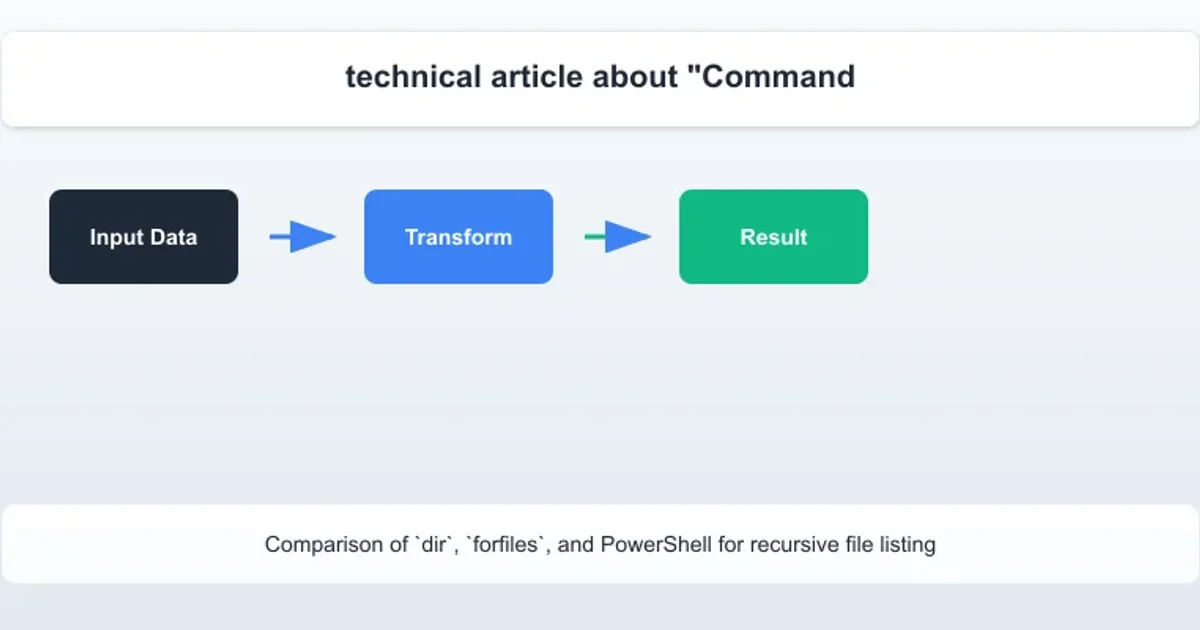Command to list all files in a folder as well as sub-folders in windows
Categories:
Listing All Files in a Folder and Subfolders on Windows

Discover various command-line methods to recursively list files and directories in Windows, from basic dir commands to more advanced PowerShell techniques.
Navigating and managing files on a Windows system often requires more than just viewing the contents of a single folder. When dealing with complex directory structures, you'll frequently need to list all files, including those nested within subfolders. This article explores several powerful command-line tools available in Windows, such as dir, forfiles, and PowerShell, to achieve comprehensive file listings. We'll cover basic usage, advanced filtering, and output redirection to help you efficiently manage your file system.
Using the 'dir' Command for Recursive Listings
The dir command is the most fundamental tool for listing directory contents in Windows. To include subfolders, you need to use the /S switch. This switch tells dir to process all subdirectories and display their contents. You can also combine it with other switches for more specific output.
dir /S
Basic recursive directory listing using dir /S
This command will list every file and subdirectory within the current directory and all its subdirectories. The output can be quite verbose. To refine the output, you can add other switches:
dir /S /B
dir /S /B /A:-D
Recursive listing with simplified output (/B) and files only (/A:-D)
/B switch (bare format) removes header information and summary, showing only the full path and filename. The /A:-D switch excludes directories, showing only files.flowchart TD
A[Start] --> B{"Current Directory"}
B --> C["dir /S"]
C --> D["List all files and subfolders"]
D --> E["dir /S /B"]
E --> F["List full paths of files and subfolders"]
F --> G["dir /S /B /A:-D"]
G --> H["List full paths of files ONLY"]
H --> I[End]Flowchart of dir command options for recursive listings
Advanced Filtering and Output with 'forfiles'
The forfiles command is a powerful utility for selecting and executing a command on files. While primarily used for batch processing, it can also be leveraged for recursive listings with more advanced filtering capabilities than dir. It's particularly useful when you need to filter by file age or specific attributes.
forfiles /S /C "cmd /c echo @path"
Listing all files and folders recursively using forfiles
In this command:
/Stellsforfilesto recurse into subdirectories./Cspecifies the command to execute on each file found."cmd /c echo @path"echoes the full path of each file or directory.@pathis a variable representing the full path.
forfiles operates on files. To include directories, you might need to adjust the command or use it in conjunction with other tools. For simple recursive file listings, dir /S /B /A:-D is often more straightforward.Leveraging PowerShell for Flexible File Listings
PowerShell offers the most flexible and powerful way to list files and folders recursively. The Get-ChildItem cmdlet is the equivalent of dir but with significantly enhanced capabilities for filtering, formatting, and object manipulation. It's the recommended approach for complex scenarios.
Get-ChildItem -Recurse
Get-ChildItem -Path "C:\MyFolder" -Recurse -File
Get-ChildItem -Path "C:\MyFolder" -Recurse -Include "*.txt", "*.log"
PowerShell commands for recursive file listings
Here's a breakdown of the PowerShell commands:
Get-ChildItem -Recurse: Lists all files and folders recursively from the current directory.Get-ChildItem -Path "C:\MyFolder" -Recurse -File: Lists only files recursively withinC:\MyFolder.Get-ChildItem -Path "C:\MyFolder" -Recurse -Include "*.txt", "*.log": Lists only.txtand.logfiles recursively withinC:\MyFolder.
Where-Object for advanced filtering or Select-Object for custom output formats.
Comparison of dir, forfiles, and PowerShell for recursive file listing